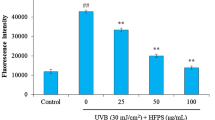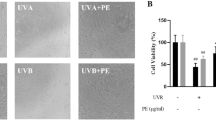Abstract
Polypeptide from Chlamys farreri (PCF, M r = 879) is a novel marine active product isolated from gonochoric Chinese scallop Chlamys farreri which has been served as sea food for several thousand years. As an octapeptide, PCF consists of 8 amino acids, namely, Pro, Asn, Ser, Thr, Arg, Hyl, Cys, and Gly. PCF had been identified as a marine chemopreventive drug that protected hairless mice's epidermis against UV-induced damage in our previous study. However, the molecular mechanisms that underlie the effect of PCF on ultraviolet A-induced apoptosis in ketatinocytes are not well understood yet. In the present study, PCF was investigated as a potential inhibitory agent for UVA-induced apoptosis in a human keratinocyte cell line, HaCaT. The effects of PCF on UVA-induced generation of ROS and MDA, DNA damage, apoptosis rate were examined. We also investigated whether PCF could inhibit UVA-induced decreasing of mitochondrial membrane potential and the changing of morphology of the cells. We found that, compared with UVA only group, PCF attenuated UVA-induced generation of ROS and MDA, increased the mitochondrial membrane potential, and decreased the apoptosis rate. These results indicate that PCF may protect HaCaT keratinocytes against UVA-induced apoptosis.
Similar content being viewed by others
References
Ahmed NU, Ueda M, Ichihashi M: Induced expression of p16 and p21 proteins in UVB-irradiated human epidermis and cultured keratinocytes. J Dermatol Sci 19: 175–181, 1999
Cunningham ML, Krinsky NI, Giovanazzi SM, Peak MJ: Superoxide anion is generated from cellular metabolites by solar radiation and its components.J Free Radic Biol Med 1: 381–386, 1985
Tebbe B, Wu S, Geilen CC, Eberle J, Kodelja V, Orfanos CE: L-ascorbic acid inhibits UVA-induced lipid peroxidation and secretion of IL-1alpha and IL-6 in cultured human keratinocytes in vitro. J Invest Dermatol 108: 302–306, 1997
Savini I, D'Angelo I, Ranalli M, Melino G, Avigliano L: Ascorbic acid maintenance in HaCaT cells prevents radical formation and apoptosis by UV-B. Free Radic Biol Med 26: 1172–1180, 1999
Lopez-Torres M, Thiele JJ, Han D, Packer L: Topical application of a-tocopherol modulates the antioxidant network and diminishes ultraviolet-induced oxidative damage in murine skin. Br J Dermatol Sci 138: 207–215, 1998
Shindo Y, Hashimoto T: Ultraviolet B-induced cell death in four cutaneous cell lines exhibiting different enzymatic antioxidant defences: Involvement of apoptosis. J Dermatol Sci 17: 140–50, 1998
O'Connor I, O'Brien N: Modulation of UVA light-induced oxidative stress by β-carotene, lutein and astaxanthin in cultured fibroblasts. J Dermatol Sci 16: 226–230, 1998
Katiyar SK, Afaq F, Azizuddin K, Mukhtar H: Inhibition of UVB-induced oxidative stress-mediated phosphorylation of mitogen-activated protein kinase signaling pathways in cultured human epidermal keratinocytes by green tea polyphenol (-)-epigallocatechin-3-gallate. Toxicol Appl Pharmacol 176: 110–117, 2001
Wang CB, Yao RY, Liu ZT, Zhong WZ, Liu XP, Wang YJ: Protective effects of polypeptide from Chlamys farreri on hairless mice damaged by ultraviolet A. Acta Pharmacol Sin 23: 813–818, 2002
Boukamp P, Petruddevdka RT, Breitkreutz D, Hornung J, Markham A, Fusenig NE: Normal keratinization in a spontaneously immortalized aneuploid human keratinocyte cell line. J Cell Biol 106: 761–771, 1988
Ibrahim W, Lee US, Yeh CC, Szabo J, Bruckner G, Chow CK: Oxidative stress and antioxidant status in mouse liver: Effects of dietary lipid, Vitamin E and Iron. J Nutr 127: 1401–1406, 1997
Shapiro HM: Membrane potential estimation by flow cytometry. Methods 21: 271–279, 2000
Li LW, Lorenzo SP, Bogi K, Blumberg MP, Yuspa HS: Protein kinase CδTargets mitochondria, alters mitochondrial membrane potential, and induces apoptosis in normal and neoplastic keratinocytes when overexpressed by an adenoviral vector.Mol Cell Biol 19: 8547–8558, 1999
Denning MF, Wang YH, Nickoloff BJ, Smith TW: Protein kinase Cδis activated by caspase-dependent proteolysis during ultraviolet radiation-induced apoptosis of human keratinocytes. J Biol Chem 273: 29995–30002, 1998
Yeh CJ, Hsi BL, Faulk WP: Propidium iodide as a nuclear marker in immunofluorescence. II. Use with cellular identification and viability studies. J Immunol Methods 43: 269–275, 1981
Petersen AB, Gniadecki R, Vicanova J, Thorn T, Wulf HC: Hydrogen peroxide is responsible for UVA-induced DNA damage measured by alkaline comet assay in HaCaT keratinocytes. J Photochem Photobiol B 59: 123–131, 2000
Suschek CV, Briviba K, Bruch-Gerharz D, Sies H, Kroncke KD, Kolb-Bachofen V: Even after UVA-exposure will nitric oxide protect cells from reactive oxygen intermediate-mediated apoptosis and necrosis. Cell Death Differ 8: 515–527, 2001
Phillipson RP, Tobi SE, Morris JA, MxMillan TJ: UV-A induces persistent genomic instability in human keratinocytes through an oxidative stress mechanism. Free Radic Biol Med 32: 474–480 2002
Sies H: Biochemistry of oxidant stress. Angew Chem Int Ed Engl 25: 1058–1071, 1986
Slyshenkov VS, Moiseenok AG, Wojtczak L: Noxious effects of oxygen reactive species on energy-coupling processes in Ehrlich ascites tumor mitochondria and the protection by pantothenic acid. Free Radic Biol Med 20: 793–800, 1996
Nakagawa Y, Okada S, Hatano M, Ebara M, Saisho H, Tokuhisa T:Downregulation of bcl-xL is relevant toUV-induced apoptosis in fibroblasts. J Biochem Mol Biol 35: 452–458, 2002
Devitt GP, Creagh EM, Cotter TG: The antioxidant 4b,5,9b,10-Tetrahydroindeno[1,2-b]indole inhibits apoptosis by preventing caspase activation following mitochondrial depolarization. Biochem Biophys Res Commun 264: 622–629, 1999
Denning MF, Wang Y, Tibudan S, Alkan S, Mickoloff BJ, Qin JZ: Caspase activation and disruption of mitochondrial membrane radiation-induced apoptosis of human kiratinocytes requires a kinase C. Cell Death 9: 40–52, 2002
Brenner C, Marzo I, Kroemer G: A revolution in apoptosis: From a nucleocentric to a mitochondriocentric perspective. Exp Gerontol 33: 543–553, 1998
Green DR, Reed JC: Mitochondria and apoptosis. Science 281: 1309–1312, 1998
Author information
Authors and Affiliations
Rights and permissions
About this article
Cite this article
Dou, M., Han, Y., Han, Z. et al. Inhibitory effect of polypeptide from Chlamys farreri on UVA-induced apoptosis in human keratinocytes. Invest New Drugs 22, 391–398 (2004). https://doi.org/10.1023/B:DRUG.0000036681.18225.32
Issue Date:
DOI: https://doi.org/10.1023/B:DRUG.0000036681.18225.32




